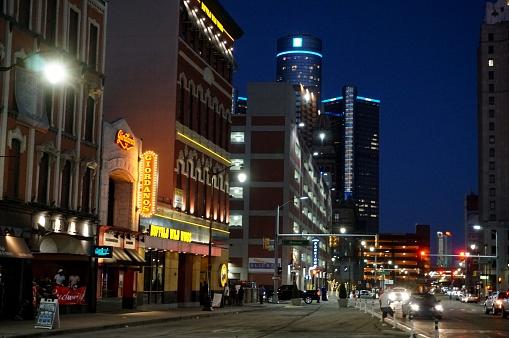We live in a world that is bursting with cameras. There is some comfort in thinking that even if our activities are recorded, nobody watches the videos until long after we’re away. But, that’s not the case anymore. The application of real-time face surveillance allows for authorities to pick you out from a crowd while you’re still in it.
It may sound like a distant dystopia, but a report from Georgetown says that for millions of Americans, it may be an imminent reality.
The report hones in on two cities in particular: Detroit and Chicago. Within the report, Senior Associate Clare Garvie and Executive Director Laura M. Moy note that Detroit has a million-dollar system that “affords police the ability to scan live video from cameras located at businesses, health clinics, schools, and apartment buildings.”
As conversations around facial recognition and surveillance pick up, it is important to remember that Black people and other communities of color are particularly vulnerable. Historically, Black communities have been under constant surveillance.
Both Chicago and Detroit are heavily Black cities. According to the United States Census Bureau, Detroit and Chicago are nearly 80 and 31 percent Black, respectively. Rolling out real-time surveillance in majority Black cities is unfortunately a natural progression of criminalization and over-policing impacting Black communities.
In July of 2017, Detroit purchased their system from DataWorks Plus in a contract totaling $1,045,843.20. The report noted that under the contract, Detroit licensed DataWorks Plus’ FACE Watch Plus real-time video surveillance software, which uses “facial searching algorithms to detect faces in surveillance footage in real-time.”
One of the most alarming things the report highlights is Detroit’s involvement with Project Greenlight, an initiative launched by the Detroit Police Department in 2016 where it partnered with eight gas stations to install real time facial recognition technology. Although Project Green Light claims to be focused on “crime-fighting”, the Georgetown researchers wrote:
From the perspective of quickly solving the crimes that aren’t deterred by the Project Green Light Signs, this may sound like a good thing. Police are able to more quickly identify repeat offenders and make arrests.
But face surveillance doesn’t identify crime; it identifies people. With such a system, all people caught on camera—passersby, patrons, or patients—are scanned, their faces compared against the face recognition database on file. For patients visiting Summit Medical Center to terminate a pregnancy, receive HIV treatment, counseling, or another service, this probably sounds less like a guarantee of safety and more like an invasion into a deeply personal moment in their lives.
- – “America Under Watch: Face Surveillance In The United States”
Chicago is no stranger to surveillance programs, either. Although Chicago police claim they do not use face surveillance, Georgetown researchers said, “the city nonetheless has paid to acquire and maintain the capability for years.” The researchers also note that Illinois has one of the most advanced biometric systems in the country.
From 2014 to 2018, Chicago used surveillance software Dunami to monitor the social media accounts of students. It’s unclear if the city ended the practice in 2019 or simply switched contractors. In addition, the Chicago Police Department and the Chicago Transit Authority have had face surveillance since at least 2016, Georgetown researchers said.
DataWorks Plus also provides a system to Chicago, which is set to compare faces to the city’s database of around seven million mugshots. Georgetown could not publish a description from an agency running the system, but obtained one from DataWorks Plus:
“… a Real Time Screening System (RTS) and a Facial Recognition System (FRS). The project objective included Real Time Screening using Facial Recognition on Chicago’s vast camera monitoring system which includes nearly 20,000 street, transit and other video cameras located throughout the city. DataWorks Plus integrated its RTS system with Chicago’s Genetec Omincast [sic] camera video streams that allow Chicago to select any number of cameras to monitor using facial recognition and a special persons of interest Watchlist mugshot database.”
- – “America Under Watch: Face Surveillance In The United States”
There’s a growing notion in the tech community that facial recognition technology shouldn’t exist at all, as Vox highlighted in an April report. Moy told AfroTech that sometimes people critiquing and dissecting facial recognition technology don’t really dive into the deeper problems that exist outside of it.
“For example, police face recognition disproportionately impacts Black people in part because Black people are overrepresented in police photo (mugshot) databases and because Black people are often scrutinized by police at a higher rate,” Moy said. “Even if the algorithms themselves performed equally accurately on faces of all colors (which they don’t do), that wouldn’t address these other problems.”
In addition to problems embedded within the technology, the application of face surveillance can violate someone’s First and Fourth Amendment rights, as outlined by the report. For example, there are obvious risks to free speech if protesters are subject to real-time face surveillance during assemblies.
Moy shared that Georgetown’s research revealed “police are using face recognition in surprising and alarming ways, including to search for suspects based on partially fabricated photos — generating leads that ultimately could result in someone getting arrested.” Defense attorneys weren’t told that the technology was used, so they had no ability to challenge it.
Police misuse of facial recognition technology was seen earlier this month. Reports found that police in Washington County, Oregon are running artist sketches through Amazon’s Rekognition program, a practice that AI experts said could increase the likelihood of a false match.
Cities across the United States are moving to ban government use of facial recognition technology. This week, San Francisco made history as the first city to do so — and although Black and brown communities are still at risk from companies privatizing surveillance, many see it as a step in the right direction.

